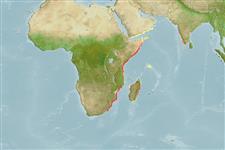>
Eupercaria/misc (Various families in series Eupercaria) >
Caesionidae (Fusiliers) > Caesioninae
Etymology: Caesio: Latin, caesius, bluish-grey, 1835; it is the same name given to the silvery metal (Cs) (Ref. 45335); xanthalytos: Name from Greek, literally meaning 'yellow line'; referring to the prominent deep yellow band along the fish’s midside; noun in apposition..
Environment: milieu / climate zone / depth range / distribution range
البيئة
بحري; مياه مخلوطة; نطاق العمق 8 - 40 m (Ref. 94071). Tropical
Western Indian Ocean: Kenya (purchased in Mombasa market), Tanzania (Dar es Salaam), southern Mozambique and KwaZulu-Natal (Margate, 30°51' S), southern Madagascar.
الحجم / وزن / العمر
Maturity: Lm ? range ? - ? cm
Max length : 22.0 cm SL ذكر/ مختلط الجنس; (Ref. 94071)
وصف مختصر
الوصف الخارجي | قياسات المظهر الخارجي
الأشواك الظهرية (المجموع): 10; الأشعة الظهرية الناعمة (المجموع): 15; شوكة شرجية 3; أشعه شرجية لينه: 11 - 12; فقرات: 23. This medium-sized species is distinguished by the following: a prominent, composite, yellow lateral band in life, bordered by irregular dark brown stripes, and with a narrow blue stripe in the yellow, above the lateral line; the lateral line is within band for most of length; 19-22 pectoral-fin rays (rarely 19 or 21, 22); 57-67 (mode 59-62) lateral line scales; 11-12 (mode 11) anal fin rays; 8 + 12 circumpeduncular scales (Ref. 94071).
This species schools with Caesio variliniata and both have been observed together in large shoals in northern KwaZulu-Natal. Prolific spawning in the Park Rynie area, KwaZulu-Natal (30°20’ S, 30°45’ E) is apparent due to abundance of eggs of this species from plankton collections (Ref. 94071).
Life cycle and mating behavior
النضج | التكاثر | وضع البيض | بيض | الخصوبة | Larvae
Holleman, W., A.D, Connell and K.E. Carpenter, 2013. Caesio xanthalytos, a new species of fusilier (Perciformes: Caesionidae) from the Western Indian Ocean, with records of range extensions for several species of Caesionidae. Zootaxa 3702(3):262-272. (Ref. 94071)
IUCN Red List Status (Ref. 130435)
استخدامات بشرية
مزيد من المعلومات
الأسماء الشائعةمرادفاتالأيضمفتريساتعلم السميات البيئيةالتكاثرالنضجوضع البيضتجمعات وضع البيضالخصوبةبيضتطور البيضة
العمر/ الحجمنموالطول-الوزنالطول-الطولالطول- التردداتقياسات المظهر الخارجيالوصف الخارجيLarvaeحركة انتقال اليرقاتتوظيفالوفرةBRUVS
مراجعالأستزراع المائيملف الأستزراع المائيسلالاتجينيElectrophoresesالتوريثالأمراضمعالجةNutrientsMass conversion
المتعاونينصورStamps, Coins Misc.اصواتالتسمم باكل السمكسرعةنوع السباحةمنطقة الخياشيمعظمة الأذندماغرؤية
أدوات
تقارير خاصة
Download XML
مصادر علي الأنترنت
Estimates based on models
Preferred temperature (Ref.
123201): 24.7 - 27.5, mean 26.7 °C (based on 42 cells).
Phylogenetic diversity index (Ref.
82804): PD
50 = 0.5020 [Uniqueness, from 0.5 = low to 2.0 = high].
Bayesian length-weight: a=0.01259 (0.00551 - 0.02875), b=3.09 (2.90 - 3.28), in cm total length, based on LWR estimates for this (Sub)family-body shape (Ref.
93245).
مستوى غذائي (Ref.
69278): 3.4 ±0.4 se; based on size and trophs of closest relatives
المرونه (Ref.
120179): عالي, الحد الزمني الأدني لتضاعف عدد أفراد المجتمع أقل من 15 شهر (Preliminary K or Fecundity.).
Fishing Vulnerability (Ref.
59153): Low vulnerability (17 of 100).
